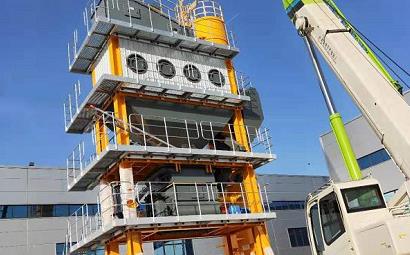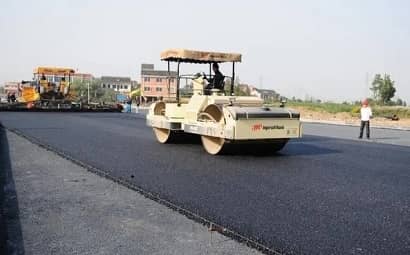First, we need to analyze the main causes of overflow in asphalt mixing plants:
1. Mix in the cold silo. There are generally five or four cold silos, each of which has particles of a certain size. If cold materials of different specifications are mixed or mistakenly installed during the feeding process, it will cause a shortage of particles of a certain specification within a certain period of time, and overflow of particles of another specification, which can easily destroy the feeding balance between hot and cold silos.
2. The composition of raw material particles of the same specification has great variability. Since there are few large-scale gravel fields on the market, different specifications of gravel are required for road surfaces, and the gravel crushers and screens used in each quarry have different models and specifications. Gravel with the same nominal specifications purchased from different gravel fields will The variability of particle composition makes it difficult for the mixing plant to control the feed balance during the mixing process, resulting in a surplus or shortage of materials and stones of certain specifications.
3. Selection of hot bin screen. Theoretically, if the gradation of the hot material bin is stable, no matter how many sieve holes are erected, it will not affect the gradation of the mixture. However, the screening of the hot silo of the mixing plant has the characteristics of particle size reduction and non-expansion, so particles of a certain size may be mixed with particles smaller than their own size. The amount of this content often has a great impact on the screen selection of the mixing plant and whether it overflows. If the curve of the mixture is smooth and the screen surface is properly selected, the finished materials produced by the mixing plant can ensure that the gradation does not overflow. Otherwise, the overflow phenomenon is unavoidable and may even be serious, causing huge material waste and economic losses.


After the asphalt mixing plant overflows, the following consequences will occur:
1. The mixture is well graded. It can be seen from the above weighing process that when the hot silo overflows into fine aggregate or large aggregate, the fine aggregate will be weighed to a predetermined amount or exceeds the range of the amount, while the large aggregate will be weighed to a predetermined amount. will be closed, resulting in insufficient compensation, resulting in overall or partial screening thinning of the entire mixture. Taking 4 hot silos as an example, the screening ranges of 1#, 2#, 3#, and 4# hot silos are 0~3mm, 3~6mm, 6~11.2~30mm, and 11.2~30mm respectively. When silo 3# overflows, silo 4# etc. , 3# silo will exceed the weighing range due to over-compensation, 4#. Similarly, when the 1# warehouse overflows, the 2# warehouse overflows, etc., the compensation amount of the 1# warehouse flying material will exceed the set amount, and the 2# warehouse will not reach the weighing capacity due to insufficient compensation amount. The setting amount, the overall gradation is good; when the 2# warehouse overflows, the 3# warehouse or the 4# warehouse overflows, it will be 3~6mm thick and 6~30mm thin.
2. Crude mixture. Coarse mixtures are caused by the larger sieve particles being too heavy or the smaller sieve particles being too light. Take the screen of the mixing plant as an example: when warehouses 1#, 2#, 3#, and 4# overflow, other warehouses will weigh accurately. Regardless of whether any one, two or three warehouses 1#, 2#, and 3# fail to weigh the set quantity, the next level of coarse particles must be replenished, which will inevitably lead to larger materials, Fewer small materials and mixes
3. There is a large deviation in the gradation of particles in the mixture. The overflow in the mixing building is mainly due to insufficient weighing of a certain level of granular materials in the hot material bin, resulting in an excess of sufficient relative amounts of one or more levels of granular materials, resulting in overflow. The production mix ratio is obtained through hot silo screening and trial mixing. Generally, after the sieve hole of the hot silo is determined, the gradation of the mixture will not change significantly in theory. At least the throughput near the sieve hole of the hot silo should remain stable. Unless there is a string of bins or a broken screen in the hot bin, there will be a large deviation in the mix grade of granules. However, in construction practice, it was found that the gradation of the mixture was unstable after selecting the screen holes.
How to control the spreading amount is one of the key issues that need to be solved during the mixing process of asphalt mixture. It should be prevented from the following aspects:
1. Stable sources of materials. The author realizes from many years of production practice that the stability of the material source is the key to overflow control. Unstably graded gravel results in a shortage or excess of a certain grade of aggregate in the mixing plant. Only when the material source is stable, the mixing plant can stably control the gradation of the mixture. Then, while ensuring the gradation, the flow rate of the mixing plant can be adjusted to balance the supply of cold materials and the supply of hot materials in a short time. need. Otherwise, the feed source will be unstable and it will be impossible to maintain a certain feed balance for a long time. It takes a period of adjustment to go from one feed balance to another, and the feed balance cannot be reached in a short period of time, resulting in overflow. Therefore, to control spillage, the stability of material sources is key.
2. Reasonable selection of hot silo screen. Two principles should be followed in screening: ① Ensure the gradation of the mixture; (2) Ensure that the overflow of the mixing plant is as small as possible.
In order to ensure the gradation of the mixture, the selection of the screen should be as close as possible to the mesh size controlled by the gradation, such as 4.75mm, 2.36mm, 0.075mm, 9.5mm, 13.2mm, etc. Considering that the screen mesh of the mixing plant has a certain inclination, the size of the screen holes should be increased proportionally.
Overflow of mixing plants has always been a difficult problem for construction units to solve. Once a leak occurs, it is difficult to effectively control it. Therefore, in order to ensure that there is as little overflow as possible in the mixing plant, it is important to match the material capacity of each hot bunker with its discharge capacity. After the grading curve of the target mix ratio is determined in the laboratory, the selection of the mixing plant screen should be based on the grading curve to balance the cold material flow and hot material demand of the mixing plant. If a certain grade of granular material is in short supply, the size range of its screen should be expanded as much as possible to ensure the demand for mixed hot materials. The specific method is as follows: Divide different sections from the mixture synthesis curve → Screen the throughput of granular materials → Determine the mesh size according to the throughput → Make the proportions of each hot bin as equal as possible → Minimize the impact of fly material compensation on gradation Influence. During the setting process, try to weigh each level of materials to the end. The smaller the warehouse door is closed, the smaller the compensation for flying materials; or a warehouse has two doors, one large and one small, and they are opened when the weighing starts. Or both doors are opened at the same time, and only the small door is opened at the end of weighing to reduce the impact of flying material compensation on grading at the end of weighing.
3. Strengthen testing guidance. The laboratory should increase the frequency of testing of raw materials based on the quantity of raw materials entering the site and changes in raw materials, make flow curves of cold silos from time to time, and feed various data back to the mixing plant in a timely manner to guide production accurately and timely, and maintain hot and cold conditions Relative feed balance of materials.
4. Improvement of asphalt mixture mixing equipment. (1) Set up multiple overflow buckets of the mixing plant, and set up an overflow bucket for each hot material bin to prevent the overflow from being mixed and making it difficult to reuse; (2) Increase the amount of flying material compensation on the control panel of the mixing plant With the display and debugging device, the mixing plant can adjust the flying material compensation amount regardless of whether it is overflowing or not, so that the mixture can maintain a stable gradation within the limit.
 Albanian
Albanian  Russian
Russian  Arabic
Arabic  Amharic
Amharic  Azerbaijani
Azerbaijani  Irish
Irish  Estonian
Estonian  Odia (Oriya)
Odia (Oriya)  Basque
Basque  Belarusian
Belarusian  Bulgarian
Bulgarian  Icelandic
Icelandic  Polish
Polish  Bosnian
Bosnian  Persian
Persian  Afrikaans
Afrikaans  Tatar
Tatar  Danish
Danish  German
German  French
French  Filipino
Filipino  Finnish
Finnish  Frisian
Frisian  Khmer
Khmer  Georgian
Georgian  Gujarati
Gujarati  Kazakh
Kazakh  Haitian Creole
Haitian Creole  Korean
Korean  Hausa
Hausa  Dutch
Dutch  Kyrgyz
Kyrgyz  Galician
Galician  Catalan
Catalan  Czech
Czech  Kannada
Kannada  Corsican
Corsican  Croatian
Croatian  Kurdish (Kurmanji)
Kurdish (Kurmanji)  Latin
Latin  Latvian
Latvian  Lao
Lao  Lithuanian
Lithuanian  Luxembourgish
Luxembourgish  Kinyarwanda
Kinyarwanda  Romanian
Romanian  Malagasy
Malagasy  Maltese
Maltese  Marathi
Marathi  Malayalam
Malayalam  Malay
Malay  Macedonian
Macedonian  Maori
Maori  Mongolian
Mongolian  Bengali
Bengali  Myanmar (Burmese)
Myanmar (Burmese)  Hmong
Hmong  Xhosa
Xhosa  Zulu
Zulu  Nepali
Nepali  Norwegian
Norwegian  Punjabi
Punjabi  Portuguese
Portuguese  Pashto
Pashto  Chichewa
Chichewa  Japanese
Japanese  Swedish
Swedish  Samoan
Samoan  Serbian
Serbian  Sesotho
Sesotho  Sinhala
Sinhala  Esperanto
Esperanto  Slovak
Slovak  Slovenian
Slovenian  Swahili
Swahili  Scots Gaelic
Scots Gaelic  Cebuano
Cebuano  Somali
Somali  Tajik
Tajik  Telugu
Telugu  Tamil
Tamil  Thai
Thai  Turkish
Turkish  Turkmen
Turkmen  Welsh
Welsh  Uyghur
Uyghur  Urdu
Urdu  Ukrainian
Ukrainian  Uzbek
Uzbek  Spanish
Spanish  Hebrew
Hebrew  Greek
Greek  Hawaiian
Hawaiian  Sindhi
Sindhi  Hungarian
Hungarian  Shona
Shona  Armenian
Armenian  Igbo
Igbo  Italian
Italian  Yiddish
Yiddish  Hindi
Hindi  Sundanese
Sundanese  Indonesian
Indonesian  Javanese
Javanese  Yoruba
Yoruba  Vietnamese
Vietnamese  Hebrew
Hebrew  Chinese (Simplified)
Chinese (Simplified)







